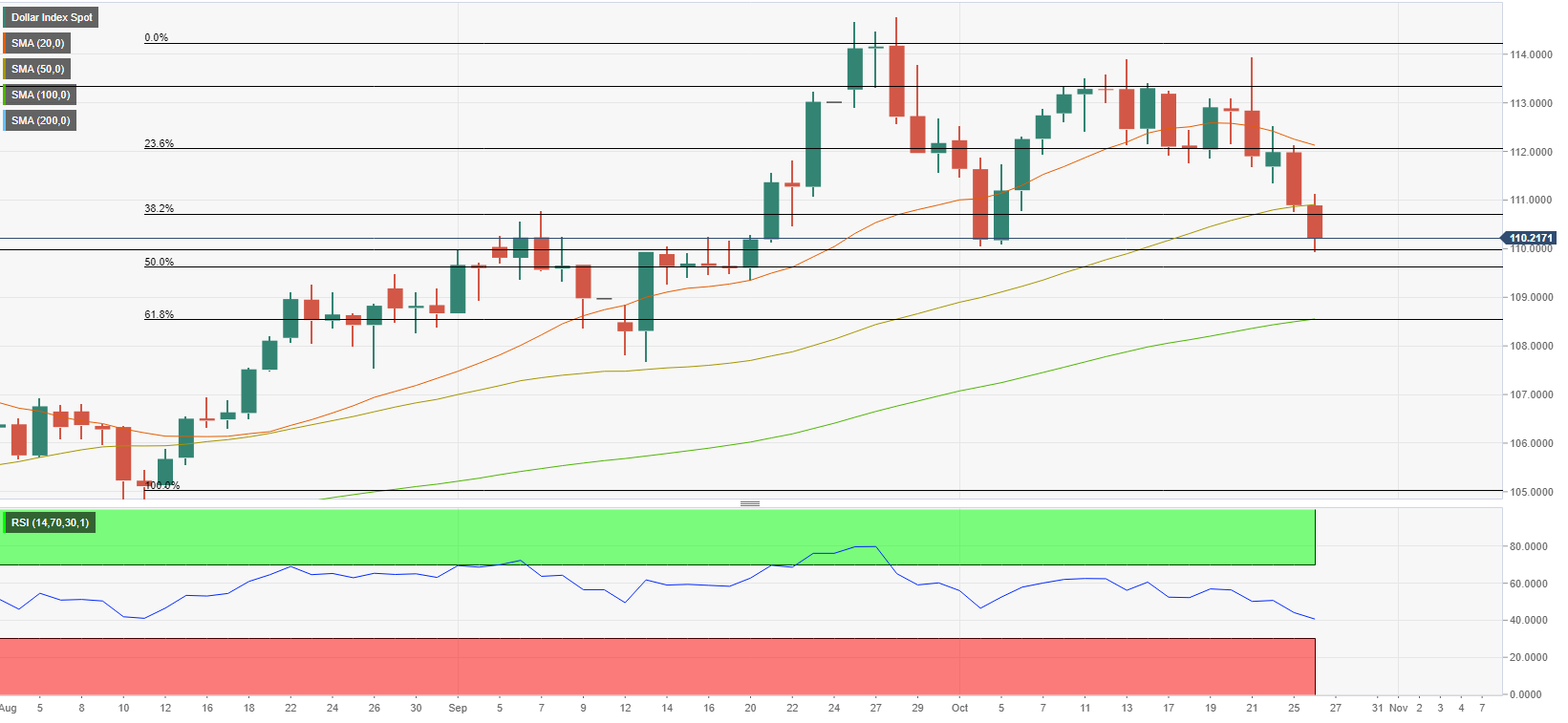- US economy is forecast to grow at an annual rate of 2.4% in Q3.
- Investors reassess Fed’s policy outlook following dismal US data.
- DXY technical picture points to a bearish tilt.
The US Bureau of Economic Analysis will release its first estimate of the third-quarter Gross Domestic Product (GDP) on Thursday, October 27. Markets forecast the US economy to expand at an annualized rate of 2.4% following the 0.6% contraction recorded in the second quarter.
The Federal Reserve Bank of Atlanta’s latest GDPNow estimate, published on October 19, however, showed that the GDP is expected to grow by 2.9% in Q3. Following the Federal Reserve’s decision to hike the policy rate by 75 basis points (bps) in September, policymakers have acknowledged the heightened risks of an economic downturn but reiterated that they will remain focused on taming inflation until they see a consistent increase in the unemployment rate – full employment being another of their key mandates. In the Summary of Economic Projections released alongside the policy statement, Fed officials projected the GDP to grow by 0.2% in 2022 and 1.2% in 2023.
Market implications
Nick Timiraos, The Wall Street Journal’s chief economics correspondent who correctly leaked the 75 bps hike a few days before the July policy meeting, wrote recently that policymakers were planning to communicate smaller rate hikes from December.
The disappointing S&P Global PMI surveys revealed earlier in the week that the economic activity in the private sector contracted at an accelerating pace in early October, triggering a dollar sell-off. Additionally, the Conference Board’s sentiment survey revealed that consumer confidence deteriorated in October, causing the greenback to continue to weaken against its major rivals.
Dismal US data releases following Timiraos’ article seem to have revived expectations for the Fed to adopt a less aggressive policy stance. According to the CME Group FedWatch Tool, markets are pricing in a more than 50% probability of the US central bank raising the policy rate by a total of 125 bps by the end of the year, compared to only 20% last week.
As mentioned above, FOMC officials are unlikely to put too much weight on the GDP report when assessing the policy outlook. However, the market reaction to the latest US data, which had not been big market movers in the past, suggests that investors might be looking for an excuse to get out of their dollar longs while re-evaluating their positions ahead of the Fed’s policy announcements on November 2. Hence, a Q3 GDP reading slightly below or at the market projection of 2.4% could force the dollar to stay on the backfoot after the kneejerk reaction, while a print below 2% could open the door for another sharp decline in the US Dollar Index (DXY). On the other hand, a GDP growth at around the Atlanta Fed’s estimate of 2.9% should help USD stay resilient against its peers, at least until next week’s Fed meeting.
DXY technical outlook
The Relative Strength Index (RSI) indicator on DXY’s daily chart declined to its lowest level since early August below 50 following the dollar sell-off witnessed in the first half of the week, pointing to a bearish tilt in the short-term outlook. On the weekly, the RSI has exited overbought, giving a sell signal. Additionally, the index broke below the 50-day SMA for the first time in over two months.
On the downside, 110.00 (psychological level) aligns as interim support. In case DXY falls below that level and starts using it as resistance, it could extend its slide toward 109.60 at around the level of a major multi-month trendline and the Fibonacci 50% retracement of the August-October uptrend. Further down still lies 108.50, the Fibonacci 61.8% retracement and the level of the 100-day SMA.
Key resistance seems to have formed at 112.00 (Fibonacci 23.6% retracement, 20-day SMA). Only a daily close above that level could be seen as a significant enough bullish development to trigger another leg higher toward 113.30 (static level) and 114.00 (end-point of the uptrend).
Information on these pages contains forward-looking statements that involve risks and uncertainties. Markets and instruments profiled on this page are for informational purposes only and should not in any way come across as a recommendation to buy or sell in these assets. You should do your own thorough research before making any investment decisions. FXStreet does not in any way guarantee that this information is free from mistakes, errors, or material misstatements. It also does not guarantee that this information is of a timely nature. Investing in Open Markets involves a great deal of risk, including the loss of all or a portion of your investment, as well as emotional distress. All risks, losses and costs associated with investing, including total loss of principal, are your responsibility. The views and opinions expressed in this article are those of the authors and do not necessarily reflect the official policy or position of FXStreet nor its advertisers. The author will not be held responsible for information that is found at the end of links posted on this page.
If not otherwise explicitly mentioned in the body of the article, at the time of writing, the author has no position in any stock mentioned in this article and no business relationship with any company mentioned. The author has not received compensation for writing this article, other than from FXStreet.
FXStreet and the author do not provide personalized recommendations. The author makes no representations as to the accuracy, completeness, or suitability of this information. FXStreet and the author will not be liable for any errors, omissions or any losses, injuries or damages arising from this information and its display or use. Errors and omissions excepted.
The author and FXStreet are not registered investment advisors and nothing in this article is intended to be investment advice.
Recommended Content
Editors’ Picks

AUD/USD moves away from multi-year low amid easing fears about Trump's tariff plans
AUD/USD builds on the overnight bounce from its lowest level since April 2020 as reports of gradual Trump tariffs boost investors' sentiment and weigh on the USD. Bets that the Fed will pause its rate-cutting cycle, the RBA's dovish shift, China's economic woes and geopolitical risks act as a headwind for the Aussie.

USD/JPY hangs near a one-week low; the downside seems protected
USD/JPY languishes near a one-week low touched the previous day amid a softer USD, weighed down by reports that advisors on Trump’s incoming economic team are considering a gradual implementation of tariffs. However, the Fed's hawkish outlook is a tailwind for the buck.

Gold price regains positive traction amid retreating US bond yields, softer USD
Gold price attracts some dip-buyers during the Asian session on Tuesday and reverses a part of the previous day's retracement slide from a one-month top. Reports that Trump's top economic advisers are mulling a slow ramp-up in tariffs to avoid a sudden spike in inflation trigger a pullback in the US bond yields, which keeps the USD bulls on the defensive and benefits the XAU/USD.

Crypto Today: BTC price plunges 4%, Litecoin X account hacked; traders position for US inflation report
The cryptocurrency sector plunged by 5% on Monday, with over $148 billion wiped off the aggregate market capitalization. Bitcoin price dropped below $90,600 for the first time in 24 days, as traders anticipate the upcoming US CPI report.

Bitcoin falls below $92,000 as exchanges show overheating conditions
Bitcoin (BTC) continues its ongoing correction, falling below $92,000 on Monday after declining almost 4% last week. CryptoQuant data shows that BTC is overheating in exchanges and suggests further decline ahead.

Best Forex Brokers with Low Spreads
VERIFIED Low spreads are crucial for reducing trading costs. Explore top Forex brokers offering competitive spreads and high leverage. Compare options for EUR/USD, GBP/USD, USD/JPY, and Gold.
